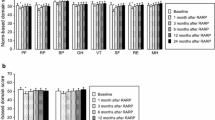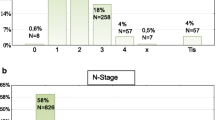Abstract
Purpose
A radical prostatectomy might lead to an impaired quality of life. Aim of the study was to analyse the impact of inpatient and outpatient rehabilitation on psychosocial and physical outcomes in patients after surgery.
Methods
Six hundred nineteen inpatients and 95 outpatients, treated for localized prostate cancer by prostatectomy, completed the Hospital Anxiety and Depression Scale (HADS) and two quality-of-life questionnaires (EORTC QLQ-C30 and EORTC QLQ-PR25) at the beginning and end of rehabilitation as well as 12 months after rehabilitation. Data were analysed by using t-tests, chi2 - tests and analyses of variance with repeated measures.
Results
Compared to a population sample, patients reported a significantly worse quality of life (EORTC QLQ-C30) and more anxiety (HADS) at the beginning of rehabilitation. Physical, role and social functioning increased significantly over time for in- and outpatients. Patients still reported lower emotional functioning (EORTC QLQ-C30), anxiety (HADS) and prostate cancer-specific physical symptoms (EORTC QLQ-PR25) 1 year after rehabilitation, although symptom levels decreased significantly over time. The setting did not have an independent significant effect in the multivariate model.
Conclusions
In- and outpatients reported an increased quality of life 1 year after rehabilitation with respect to their physical constitution and their reintegration into social life. Nonetheless, both groups still struggled with problems due to surgery. The results indicated that both settings seem to be supportive in the recovery process but that patients seem to require additional support with aftercare for treating surgery-related problems as well as emotional discomfort.

Similar content being viewed by others
References
Robert Koch - Institut & Gesellschaft der epidemiologischen Krebsregister in Deutschland e. V. (2013) Krebs in Deutschland 2009/2010. Eine gemeinsame Veröffentlichung des Robert Koch-Instituts und der Gesellschaft der epidemiologischen Krebsregister in Deutschland e. V., Berlin
GLOBOCAN (IARC) (2014) Section of Cancer Information, 2012. Available at: http://globocan.iarc.fr/Default.aspx [retrieved: 13.07.2015]
Heidenreich A, Bolla M, Joniau S, Mason MD, Matveev V, Mottet N, Schmid H-P, van der Kwast TH, Wiegel T, Zattoni F (2010) Guidelines on prostate cancer. European Association of Urology. Available at: http://uroweb.org/wp-content/uploads/Prostate-Cancer-2010-June-17th.pdf [retrieved: 13.07.2015]
Hellbom M, Bergelt C, Bergenmar M, Gijsen B, Loge JH, Rautalathi M, Smaradottir A, Johansen C (2011) Cancer rehabilitation: a Nordic and European perspective. Acta Oncol 50:179–186
Alfano CM, Ganz PA, Rowland JH, Hahn EE (2012) Cancer survivorship and cancer rehabilitation: revitalizing the link. J Clin Oncol 30:904–906
Deutsche Rentenversicherung Bund (2014) Abgeschlossene Leistungen zur Rehabilitation. Rentenversicherung in Zeitreihen: 223–240
Bundesarbeitsgemeinschaft für Rehabilitation (2004) Rahmenempfehlungen zur ambulanten onkologischen Rehabiliation vom 22. Januar 2004. Bundesarbeitsgemeinschaft für Rehabilitation (BAR), Frankfurt a. M
Hartmann U, Kluge A, Ring C, Reuss-Borst M (2006) Improvement of anxiety and depression in women with breast cancer during inpatient oncological rehabilitation-results of a prospective study. Rehabilitation (Stuttg) 45:88–94
Dombo O, Otto U (2005) Quality of life after radical urologic pelvic surgery and impact of inpatient rehabilitation. Urologe A 44:11–28
Weis J, Moser TM, Fachinger D, Bartsch HH (2002) Zielorientierte Evaluation von Maßnahmen der stationären onkologischen Rehabilitation. In: Bengel J, Jäckel WH (eds) Zielorientierte Evaluation in der Rehabilitation. Rehabilitationswissenschaftlicher Forschungsverbund Freiburg/Bad Säckingen. Roderer, Regensburg
Koch U, Gundelach C, Tiemann F, Mehnert A (2000) Partial inpatient oncologic rehabilitation-results of a model project. Rehabilitation (Stuttg) 39:363–372
Lehmann C, Bergelt C, Welk H-J, Hagen-Aukamp C, Berger D, Koch U (2008) Do outpatient and inpatient rehabilitation programs differ in applied interventions and success? An analysis of medical discharge summaries. Phys Rehab Kur Med 18:59–68
Silver JK, Baima J, Mayer RS (2013) Impairment-driven cancer rehabilitation: an essential component of quality care and survivorship. CA Cancer J Clin 63:295–317
Silver JK, Baima J, Newman R, Galantino ML, Shockney LD (2013) Cancer rehabilitation may improve function in survivors and decrease the economic burden of cancer to individuals and society. Work 46:455–472
Oldervoll LM, Kaasa S, Hjermstad MJ, Lund JA, Loge JH (2004) Physical exercise results in the improved subjective well-being of a few or is effective rehabilitation for all cancer patients? Eur J Cancer 40:951–962
Stubblefield MD, Schmitz KH, Ness KK (2013) Physical functioning and rehabilitation for the cancer survivor. Semin Oncol 40:784–795
Holley S, Borger D (2001) Energy for living with cancer: preliminary findings of a cancer rehabilitation group intervention study. Oncol Nurs Forum 28:1393–1396
Strasser F, Sweeney C, Willey J, Benisch-Tolley S, Palmer JL, Bruera E (2004) Impact of a half-day multidisciplinary symptom control and palliative care outpatient clinic in a comprehensive cancer center on recommendations, symptom intensity, and patient satisfaction: a retrospective descriptive study. J Pain Symptom Manag 27:481–491
Stubblefield MD, Hubbard G, Cheville A, Koch U, Schmitz KH, Dalton SO (2013) Current perspectives and emerging issues on cancer rehabilitation. Cancer 119:2170–2178
Winkler J, Stolzenberg H (1999) [Social class index in the Federal Health Survey.] Gesundheitswesen 61(Sonderheft 2):S178–183
Aaronson NK, Ahmedzai S, Bergman B, Bullinger M, Cull A, Duez NJ, Filiberti A, Flechtner H, Fleishman SB, de Haes JC et al (1993) The European organization for research and treatment of cancer QLQ-C30: a quality-of-life instrument for use in international clinical trials in oncology. J Natl Cancer Inst 85:365–376
van Andel G, Bottomley A, Fossa SD, Efficace F, Coens C, Guerif S, Kynaston H, Gontero P, Thalmann G, Akdas A, D’Haese S, Aaronson NK (2008) An international field study of the EORTC QLQ-PR25: a questionnaire for assessing the health-related quality of life of patients with prostate cancer. Eur J Cancer 44:2418–2424
Zigmond AS, Snaith RP (1983) The hospital anxiety and depression scale. Acta Psychiatr Scand 67:361–70
Schwarz R, Hinz A (2001) Reference data for the quality of life questionnaire EORTC QLQ-C30 in the general German population. Eur J Cancer 37:1345–1351
Hinz A, Schwarz R (2001) Anxiety and depression in the general population: normal values in the Hospital Anxiety and Depression Scale. Psychother Psychosom Med Psychol 51:193–200
Kjaer TK, Johansen C, Ibfelt E, Christensen J, Rottmann N, Hoybye MT, Ross L, Svendsen M, Dalton SO (2011) Impact of symptom burden on health related quality of life of cancer survivors in a Danish cancer rehabilitation program: a longitudinal study. Acta Oncol 50:223–232
Osoba D, Rodrigues G, Myles J, Zee B, Pater J (1998) Interpreting the significance of changes in health-related quality-of-life scores. J Clin Oncol 16:139–144
Litwin MS, Gore JL, Kwan L, Brandeis JM, Lee SP, Withers HR, Reiter RE (2007) Quality of life after surgery, external beam irradiation, or brachytherapy for early-stage prostate cancer. Cancer 109:2239–2247
Litwin MS, Hays RD, Fink A, Ganz PA, Leake B, Leach GE, Brook RH (1995) Quality-of-life outcomes in men treated for localized prostate cancer. JAMA 273:129–135
Namiki S, Arai Y (2010) Health-related quality of life in men with localized prostate cancer. Int J Urol 17:125–138
Sanda MG, Dunn RL, Michalski J, Sandler HM, Northouse L, Hembroff L, Lin X, Greenfield TK, Litwin MS, Saigal CS, Mahadevan A, Klein E, Kibel A, Pisters LL, Kuban D, Kaplan I, Wood D, Ciezki J, Shah N, Wei JT (2008) Quality of life and satisfaction with outcome among prostate-cancer survivors. N Engl J Med 358:1250–1261
Ferrer M, Suarez JF, Guedea F, Fernandez P, Macias V, Marino A, Hervas A, Herruzo I, Ortiz MJ, Villavicencio H, Craven-Bratle J, Garin O, Aguilo F, Multicentric Spanish Group of Clinically Localized Prostate Cancer (2008) Health-related quality of life 2 years after treatment with radical prostatectomy, prostate brachytherapy, or external beam radiotherapy in patients with clinically localized prostate cancer. Int J Radiat Oncol 72:421–432
Lampert T, Kroll LE, von der Lippe E, Muters S, Stolzenberg H (2013) Socioeconomic status and health. Results of the German health interview and examination survey for adults (DEGS1). Bundesgesundhbl Gesundheitsforsch Gesundheitsschutz 56:814–821
Gülich M, Jäckel WH (2007) Zugang zur Rehabilitation, Rehabilitationsbedarf/-fähigkeit/-potential/-prognose. In: Morfeld M, Mau W, Jäckel WH, Koch U (eds) Querschnitt Rehabilitation, Physikalische Medizin und Naturheilverfahren. Ein fallorientiertes Lehrbuch. Urban, München, pp. 25–31
Acknowledgments
This study was funded by the “Nordrhein-Westfalen Association for the Fight Against Cancer, Germany” (Arbeitsgemeinschaft für Krebsbekämpfung im Lande Nordrhein-Westfalen, ARGE).
Author information
Authors and Affiliations
Corresponding author
Rights and permissions
About this article
Cite this article
Rath, H.M., Ullrich, A., Otto, U. et al. Psychosocial and physical outcomes of in- and outpatient rehabilitation in prostate cancer patients treated with radical prostatectomy. Support Care Cancer 24, 2717–2726 (2016). https://doi.org/10.1007/s00520-016-3076-7
Received:
Accepted:
Published:
Issue Date:
DOI: https://doi.org/10.1007/s00520-016-3076-7




